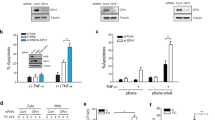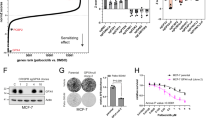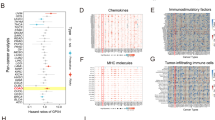Abstract
Glutathione peroxidase 4 (GPX4) is a key intracellular antioxidant enzyme that maintains oxidative homeostasis by catalyzing the reduction of lipid peroxides and relies on glutathione-specific inhibition of iron death. In recent years, it has been found that GPX4 exhibits significant aberrant expression in breast cancer (BC) and promotes BC development by regulating tumor cell proliferation, invasion, metastasis, and stem cell properties. More importantly, GPX4 overexpression leads to decreased sensitivity of BC to chemotherapy, radiotherapy, endocrine therapy, immune checkpoint inhibitors, and targeted therapies by inhibiting iron death, attenuating oxidative damage, and activating pro-survival signaling pathways. In this paper, we systematically review the molecular characterization of GPX4 and its cancer-promoting mechanism in BC, focusing on resolving its molecular regulatory network in multimodal therapy resistance. Based on the reversal of drug resistance and synergistic anti-tumor effects demonstrated by GPX4 inhibitors in preclinical studies, iron death induction strategies targeting GPX4 or combining with existing therapies are expected to be a new direction to overcome the bottleneck of drug resistance in BC.
This is a preview of subscription content, access via your institution
Access options
Subscribe to this journal
Receive 12 print issues and online access
$259.00 per year
only $21.58 per issue
Buy this article
- Purchase on SpringerLink
- Instant access to full article PDF
Prices may be subject to local taxes which are calculated during checkout



Similar content being viewed by others
References
Angela NG, Hyuna S, Kimberly DM, Joan LK, Lisa AN, Adair M, et al. Breast Cancer Statistics, 2022. CA Cancer J Clin. 2022;72:524–41.
Ye F, Dewanjee S, Li Y, Jha N, Chen Z, Kumar A, et al. Advancements in clinical aspects of targeted therapy and immunotherapy in breast cancer. Mol Cancer. 2023;22:105.
Madhuchhanda R, Amy MF, Gary AU, Aparna M. Molecular classification of breast cancer. PET Clin. 2023;18:441–58.
Fiorenza DR, Bruno M, Maria Carmen DS, Antonella F, Lorenza M, Riccardo Ray C. et al. Rethinking breast cancer follow-up based on individual risk and recurrence management. Cancer Treat Rev. 2022;109:102434.
Harshini S, Sangilimuthu Alagar KS, Extensive Y. review on breast cancer its etiology, progression, prognostic markers, and treatment. Med Oncol. 2023;40:238.
Lining Z, Wansong Z, Hao Z, Rutao L. Kidney Toxicity and Response of Selenium Containing Protein-glutathione Peroxidase (Gpx3) to CdTe QDs on Different Levels. Toxicol Sci. 2018;168:201–8.
Leopold F, Stefano T, Laura O. The glutathione peroxidase family: Discoveries and mechanism. Free Radic Biol Med. 2022;187:113–22.
Kamari W, Rachid S. The Selenoprotein Glutathione Peroxidase 4: From molecular mechanisms to novel therapeutic opportunities. Biomedicines. 2022;10:891.
Xie Y, Kang R, Klionsky D, Tang D. GPX4 in cell death, autophagy, and disease. Autophagy. 2023;19:2621–38.
Liu Y, Wan Y, Jiang Y, Zhang L, Cheng W. GPX4: The hub of lipid oxidation, ferroptosis, disease and treatment. Biochim et Biophys Acta Rev cancer. 2023;1878:188890.
Kirill B, Joseph MH, Zhipeng L, Leslie M, Breanna F, Peter HT, et al. The CoQ oxidoreductase FSP1 acts parallel to GPX4 to inhibit ferroptosis. Nature. 2019;575:688–92.
Mutian J, Danhui Q, Chunyuan Z, Li C, Zhongxia Y, Wenwen W. et al. Redox homeostasis maintained by GPX4 facilitates STING activation. Nat Immunol. 2020;21:727–35.
Vaishali A, Hardeep Singh T, Ayşegül V, Falak T, Mukerrem Betul Y, Katrin S. et al. Role of Reactive Oxygen Species in Cancer Progression: Molecular Mechanisms and Recent Advancements. Biomolecules. 2019;9:735.
Dunyaporn T, Jerome A, Peng H. Targeting cancer cells by ROS-mediated mechanisms: a radical therapeutic approach?. Nat Rev Drug Discov. 2009;8:579–91.
Chiara G, Isaac SH, Tak WM. Modulation of oxidative stress as an anticancer strategy. Nat Rev Drug Discov. 2013;12:931–47.
Jihye Y, Edouard M, Changyuan L, Kaitlyn NB, Adam K, Keith R. et al. Vitamin C selectively kills KRAS and BRAF mutant colorectal cancer cells by targeting GAPDH. Science. 2015;350:1391–96.
Jing C, Zhijie O, Tiantian G, Yuwei Y, Anmei S, Huiqin X. et al. Ginkgolide B alleviates oxidative stress and ferroptosis by inhibiting GPX4 ubiquitination to improve diabetic nephropathy. Biomed Pharmacother. 2022;156:113953.
Yu'e L, Shiping L, Lei-Lei W, Liang Y, Lixue Y, Jinghan W. The diversified role of mitochondria in ferroptosis in cancer. Cell Death Dis. 2023;14:519.
Chong Z, Jie L, Ketao Z, Huohui O, Ke S, Qingbo L. et al. SHARPIN promotes cell proliferation of cholangiocarcinoma and inhibits ferroptosis via p53/SLC7A11/GPX4 signaling. Cancer Sci. 2022;113:3766–75.
Yin Y, Zhian C, Hao Z, Cailing C, Ming Z, Joseph Y. et al. Selenium-GPX4 axis protects follicular helper T cells from ferroptosis. Nat Immunol. 2021;22:1127–39.
Kuo S, Xujie W, Yunwei W, Yanhui J, Yue Z, Kejia W, et al. miR-125b-5p in adipose derived stem cells exosome alleviates pulmonary microvascular endothelial cells ferroptosis via Keap1/Nrf2/GPX4 in sepsis lung injury. Redox Biol. 2023;62:102655.
Kim N, Andreas S, Nobuhiko K, Vishva MD. Cell death. Cell. 2024;187:235–56.
Lorenzo G, Ilio V, Stuart AA, John MA, Dieter A, Patrizia A. et al. Molecular mechanisms of cell death: recommendations of the Nomenclature Committee on Cell Death 2018. Cell Death Differ. 2018;25:486–41.
Rumani S, Anthony L, Kristopher S. Regulation of apoptosis in health and disease: the balancing act of BCL-2 family proteins. Nat Rev Mol Cell Biol. 2019;20:175–93.
Ran Q, Liang H, Gu M, Qi W, Walter CA, Roberts LJ 2nd, et al. Transgenic mice overexpressing glutathione peroxidase 4 are protected against oxidative stress-induced apoptosis. J Biol Chem. 2004;279:55137–46.
Huei-Sheng H, Wen Chang C, Ching Jiunn C. Involvement of reactive oxygen species in arsenite-induced downregulation of phospholipid hydroperoxide glutathione peroxidase in human epidermoid carcinoma A431 cells. Free Radic Biol Med. 2002;33:864–73.
Yansong X, Daniel ET, Wei Hong T, Callum K, Si Ming M. Emerging Activators and Regulators of Inflammasomes and Pyroptosis. Trends Immunol. 2019;40:1035–52.
Yang W, SriRamaratnam R, Welsch M, Shimada K, Skouta R, Viswanathan V, et al. Regulation of ferroptotic cancer cell death by GPX4. Cell. 2014;156:317–31.
Regina B-F, Matilde M. Glutathione peroxidases. Biochim Biophys Acta. 2012;1830:3289–303.
Xiaoguang L, Kellen O, Yilei Z, Esther WL, Jiejun S, Xiaoshan Z, et al. Cystine transporter regulation of pentose phosphate pathway dependency and disulfide stress exposes a targetable metabolic vulnerability in cancer. Nat Cell Biol. 2020;22:476–86.
Scott JD, Kathryn ML, Michael RL, Rachid S, Eleina MZ, Caroline EG, et al. Ferroptosis: an iron-dependent form of nonapoptotic cell death. Cell. 2012;149:1060–72.
Dana EC, Junying Y. Necroptosis as an alternative form of programmed cell death. Curr Opin Cell Biol. 2010;22:263–8.
Bersuker K, Hendricks J, Li Z, Magtanong L, Ford B, Tang P, et al. The CoQ oxidoreductase FSP1 acts parallel to GPX4 to inhibit ferroptosis. Nature. 2019;575:688–92.
Behrouz H, Peter V, Tom VB. Targeting ferroptosis to iron out cancer. Cancer Cell. 2019;35:830–49.
Sha R, Xu Y, Yuan C, Sheng X, Wu Z, Peng J, et al. Predictive and prognostic impact of ferroptosis-related genes ACSL4 and GPX4 on breast cancer treated with neoadjuvant chemotherapy. EBioMedicine. 2021;71:103560.
Jose Pedro FA, Manuela S, Bettina P, Yulia YT, Vladimir AT, Victoria JH, et al. Inactivation of the ferroptosis regulator Gpx4 triggers acute renal failure in mice. Nat Cell Biol. 2014;16:1180–91.
Le J, Ning K, Tongyuan L, Shang-Jui W, Tao S, Hanina H, et al. Ferroptosis as a p53-mediated activity during tumour suppression. Nature. 2015;520:57–62.
Brent RS, José Pedro FA, Hülya B, Ashley IB, Marcus C, Scott JD, et al. Ferroptosis: A regulated cell death nexus linking metabolism, redox biology, and Disease. Cell. 2017;171:273–85.
Vasanthi SV, Matthew JR, Harshil DD, Shubhroz G, Ossia ME, Brinton S-L, et al. Dependency of a therapy-resistant state of cancer cells on a lipid peroxidase pathway. Nature. 2017;547:453–7.
Jinxin X, Huiming H, Xuejiao W, Peng T, Lishan O, Longyan W, et al. Boswellia carterii n-hexane extract suppresses breast cancer growth via induction of ferroptosis by downregulated GPX4 and upregulated transferrin. Sci Rep. 2024;14:14307.
Bowen L, Zixian W, Zhiyue W, Fangqi X, Jinhua Y, Baiqiang L, et al. Fusobacterium nucleatum induces oxaliplatin resistance by inhibiting ferroptosis through E-cadherin/β-catenin/GPX4 axis in colorectal cancer. Free Radic Biol Med. 2024;220:125–38.
Minglang G, Kai L, Yu D, Zilong L, Congkuan S, Wenjie W, et al. Eriocitrin inhibits epithelial-mesenchymal transformation (EMT) in lung adenocarcinoma cells via triggering ferroptosis. Aging. 2023;15:10089–104.
Park M, Kim D, Ko S, Kim A, Mo K, Yoon H. Breast cancer metastasis: mechanisms and therapeutic implications. Int J Mol Sci. 2022;23:6806.
Forcina G, Dixon S. GPX4 at the crossroads of lipid homeostasis and ferroptosis. Proteomics. 2019;19:e1800311.
Ding Y, Chen X, Liu C, Ge W, Wang Q, Hao X, et al. Identification of a small molecule as inducer of ferroptosis and apoptosis through ubiquitination of GPX4 in triple negative breast cancer cells. J Hematol Oncol. 2021;14:19.
Zhang X, Sui S, Wang L, Li H, Zhang L, Xu S, et al. Inhibition of tumor propellant glutathione peroxidase 4 induces ferroptosis in cancer cells and enhances anticancer effect of cisplatin. J Cell Physiol. 2020;235:3425–37.
Lv C, Qu H, Zhu W, Xu K, Xu A, Jia B, et al. Low-Dose Paclitaxel inhibits tumor cell growth by regulating glutaminolysis in colorectal carcinoma cells. Front Pharm. 2017;8:244.
Guo J, Xu B, Han Q, Zhou H, Xia Y, Gong C, et al. Ferroptosis: A novel anti-tumor action for Cisplatin. Cancer Res Treat. 2018;50:445–60.
Hangauer M, Viswanathan V, Ryan M, Bole D, Eaton J, Matov A, et al. Drug-tolerant persister cancer cells are vulnerable to GPX4 inhibition. Nature. 2017;551:247–50.
Mattia Z, Valentina B-T, Maria Luisa DP, Marco F, Matilde M, Giovanni M, et al. Redox status in a model of cancer stem cells. Arch Biochem Biophys. 2016;617:120–8.
Si-Wei W, Chao G, Yi-Min Z, Li Y, Jia-Cheng L, Xiao-Yong H, et al. Current applications and future perspective of CRISPR/Cas9 gene editing in cancer. Mol Cancer. 2022;21:57.
Christine A, Sohyoung H, David AJ. Radiotherapy for cancer: present and future. Adv Drug Deliv Rev. 2017;109:1–2.
Shan L, Hai-Liang Z, Jing L, Zhi-Peng Y, Tian D, Li-Chao L, et al. Tubastatin A potently inhibits GPX4 activity to potentiate cancer radiotherapy through boosting ferroptosis. Redox Biol. 2023;62:102677.
Xueting L, Michael DG, Weimin W, Jiali Y, Jae Eun C, Long J, et al. Radiotherapy and Immunotherapy Promote Tumoral Lipid Oxidation and Ferroptosis via Synergistic Repression of SLC7A11. Cancer Discov. 2019;9:1673–85.
Lijuan Z, Shuaishuai D, Yuhua C, Chenglong L, Bin Z, Zhili M, et al. A MOF-based potent ferroptosis inducer for enhanced radiotherapy of triple negative breast cancer. ACS Nano. 2023;17:13195–210.
Yujun B, Guanghao L, Siqi L, Hui Z, Xiaodan W, Rui Y, et al. Multifunctional tumor-targeting carbon dots for tumor microenvironment activated ferroptosis and immunotherapy in cancer treatment. ACS Appl Mater Interfaces. 2023;15:56834–45.
Cameron SF, Francesc B, Ryan LK, Daniel JP, Alanna MC, David ES, et al. Mitochondrial Integrity Regulated by Lipid Metabolism Is a Cell-Intrinsic Checkpoint for Treg Suppressive Function. Cell Metab. 2019;31:422–37.e5.
Chengxian X, Shaogang S, Travis J, Rong Q, Siyuan Z, Jie Z, et al. The glutathione peroxidase Gpx4 prevents lipid peroxidation and ferroptosis to sustain Treg cell activation and suppression of antitumor immunity. Cell Rep. 2021;35:109235.
Tomasz M, Wei W, Joel C, Hongjuan Z, Weimin W, Shuang W, et al. Oxidative stress controls regulatory T cell apoptosis and suppressor activity and PD-L1-blockade resistance in tumor. Nat Immunol. 2017;18:1332–41.
Daniel PH, Nuo X, Aatish T, Cherise G, Susana G-R, Kevin RM, et al. B Cells and T Follicular Helper Cells Mediate Response to Checkpoint Inhibitors in High Mutation Burden Mouse Models of Breast Cancer. Cell. 2019;179:1191–206.e21.
Wang W, Green M, Choi J, Gijón M, Kennedy P, Johnson J, et al. CD8 T cells regulate tumour ferroptosis during cancer immunotherapy. Nature. 2019;569:270–4.
Richard SF, Miguel M, Hope SR, Stephen J, Seock-Ah I, Karen G, et al. Palbociclib and Letrozole in advanced breast cancer. N Engl J Med. 2016;375:1925–36.
Stephen RDJ, Nadia H, Roberto H, Masakazu T, Miguel M, Zhi Min S, et al. Abemaciclib combined with endocrine therapy for the adjuvant treatment of HR+, HER2-, node-positive, high-risk, early breast cancer (monarchE). J Clin Oncol. 2020;38:3987–98.
Stephen J, Joyce OS, Miguel M, Jens H, Masakazu T, Joohyuk S, et al. Abemaciclib as initial therapy for advanced breast cancer: MONARCH 3 updated results in prognostic subgroups. NPJ Breast Cancer. 2021;7:80.
Herrera-Abreu MT, Guan J, Khalid U, Ning J, Costa MR, Chan J, et al. Inhibition of GPX4 enhances CDK4/6 inhibitor and endocrine therapy activity in breast cancer. Nat Commun. 2024;15:9550.
Zhi X, Xiumei W, Wenbo S, Fan X, Hengyuan K, Weizi H, et al. RelB-activated GPX4 inhibits ferroptosis and confers tamoxifen resistance in breast cancer. Redox Biol. 2023;68:102952.
Erva O, Filiz B-A Etoposide in combination with erastin synergistically altered iron homeostasis and induced ferroptotic cell death through regulating IREB2/FPN1 expression in estrogen receptor positive-breast cancer cells. Life Sci. 2022;312:121222.
Dorian MC, Chuying H, Karoline CS, Radosveta G, Michael HR, Qing C, et al. The ferroptosis inducing compounds RSL3 and ML162 are not direct inhibitors of GPX4 but of TXNRD1. Redox Biol. 2023;62:102703.
Tan X, Kong D, Tao Z, Cheng F, Zhang B, Wang Z, et al. Simultaneous inhibition of FAK and ROS1 synergistically repressed triple-negative breast cancer by upregulating p53 signalling. Biomark Res. 2024;12:13.
Gu J, Qian S, Qian F, Wu X, Chen L, Chen X, et al. GPX4 inhibition enhances the antitumor effect of PARP inhibitor on homologous recombination proficient ovarian cancer cells. Current Cancer Drug Targets. 2024:72–82.
He G, Bao N, Wang S, Xi M, Zhang T, Chen F. Ketamine induces ferroptosis of liver cancer cells by targeting lncRNA PVT1/miR-214-3p/GPX4. Drug Des, Dev Ther. 2021;15:3965–78.
Qiao Y, Su M, Zhao H, Liu H, Wang C, Dai X, et al. Targeting FTO induces colorectal cancer ferroptotic cell death by decreasing SLC7A11/GPX4 expression. J Exp Clin cancer Res : CR. 2024;43:108.
Zhou C, Yu T, Zhu R, Lu J, Ouyang X, Zhang Z, et al. Timosaponin AIII promotes non-small-cell lung cancer ferroptosis through targeting and facilitating HSP90 mediated GPX4 ubiquitination and degradation. Int J Biol Sci. 2023;19:1471–89.
Cheng L, He Q, Liu B, Chen L, Lv F, Li X, et al. SGK2 promotes prostate cancer metastasis by inhibiting ferroptosis via upregulating GPX4. Cell Death Dis. 2023;14:74.
Lu Y, Yang Q, Su Y, Ji Y, Li G, Yang X, et al. MYCN mediates TFRC-dependent ferroptosis and reveals vulnerabilities in neuroblastoma. Cell Death Dis. 2021;12:511.
Zhang W, Gong M, Zhang W, Mo J, Zhang S, Zhu Z, et al. Thiostrepton induces ferroptosis in pancreatic cancer cells through STAT3/GPX4 signalling. Cell death Dis. 2022;13:630.
Sun Y, Berleth N, Wu W, Schlütermann D, Deitersen J, Stuhldreier F, et al. Fin56-induced ferroptosis is supported by autophagy-mediated GPX4 degradation and functions synergistically with mTOR inhibition to kill bladder cancer cells. Cell Death Dis. 2021;12:1028.
Zheng Y, Li L, Chen H, Zheng Y, Tan X, Zhang G, et al. Luteolin exhibits synergistic therapeutic efficacy with erastin to induce ferroptosis in colon cancer cells through the HIC1-mediated inhibition of GPX4 expression. Free Radic Biol Med. 2023;208:530–44.
Niu F, Yang R, Feng H, Liu Y, Liu R, Ma B. A GPX4 non-enzymatic domain and MDM2 targeting peptide PROTAC for acute lymphoid leukemia therapy through ferroptosis induction. Biocheml Biophys Res Commun. 2023;684:149125.
Funding
The Key Research and Development Project of Zhenjiang (FZ2021057, SH2016030) Jiangsu Health International Exchange Program.
Author information
Authors and Affiliations
Contributions
GTY contribution included Data curation, writing the original draft, Resources, and Validation. WK's contribution included Methodology and formal Analysis. YX、 THW, and WSC’s contributions included conceptualization and investigation. ZZH’s contribution included Project administration, Writing, review, and editing. All authors reviewed the manuscript.
Corresponding author
Ethics declarations
Competing interests
The authors declare no competing interests.
Ethics
Approval of the research protocol by an Institutional Reviewer Board: N/A. Registry and the Registration No. of the study/trial: N/A. Animal Studies: N/A.
Additional information
Publisher’s note Springer Nature remains neutral with regard to jurisdictional claims in published maps and institutional affiliations.
Rights and permissions
Springer Nature or its licensor (e.g. a society or other partner) holds exclusive rights to this article under a publishing agreement with the author(s) or other rightsholder(s); author self-archiving of the accepted manuscript version of this article is solely governed by the terms of such publishing agreement and applicable law.
About this article
Cite this article
Gu, T., Wang, K., Yuan, X. et al. The dual role of GPX4 in breast cancer: mechanisms of therapeutic resistance and potential for novel targeted therapies. Cancer Gene Ther 32, 913–922 (2025). https://doi.org/10.1038/s41417-025-00927-3
Received:
Revised:
Accepted:
Published:
Issue date:
DOI: https://doi.org/10.1038/s41417-025-00927-3



